Ah, blogging—the wonderful world of content marketing. Do you want to know where blogging stands today?
I’ve scoured various market data websites to bring you over 60 great business blogging stats and facts, some of which will wow you.
There are some pretty impressive numbers in this list. I’ll be sharing my favorites, so let’s get started.
Top 5 Business Blogging Statistics
- Blogs are a source of trusted information for 81% of consumers.
- 59% of people share articles without reading them first.
- On average, people read blog posts only for 52 seconds.
- 75% of people only look at the first page of search engines.
- 6 out of 10 bloggers write one to five guest posts a month.
General Blogging Statistics & Facts
The first set of blogging stats will give you an idea of the size of the blogging industry and an overview of blogging trends.
77% of Internet Users Read Blogs. (LinkedIn)
Businesses often emphasize how many people use social media like Facebook and Twitter. But few people talk about how powerful blogging can be.
Over 77% of people who use the internet read blogs. It’s even more impressive when you realize those same internet users read an average of ten blog posts daily.
One-Third of All Websites Contain a Blog. (Hosting Tribunal)
There are over 600 million blogs in the world today. It’s a mind-boggling figure, given that there are only about 1.9 billion websites.
That means that roughly one-third of all websites are blogs! Clearly, blogging is a popular activity.
Roughly 32 Million People in the US Identify Themselves As Bloggers. (Statista)
Blogging is a popular career choice for many people—not just those in business.
Statista reports that there are approximately 32 million bloggers in the United States alone. In the next few years, that number is likely to go up.
The Top Blogs Can Make Over $1 Million per Year. (Hosting Tribunal)
A small group of bloggers earns a comfortable living from their writing. Estimates show that the top 0.6% of bloggers generate seven figures a year in revenue.
The top 10% of bloggers also make over $10,000 per year. That’s not full-time, but it’s a good side gig.

Americans Spend 3x More Time Reading Blogs Than They Do Reading Email. (Social Media Today)
Average Americans spend three times as long reading blogs as they do email. They tend to trust blogs more than email, which is often full of spam messages.
While email marketing is still crucial for business, blogs are favorable for leisure reading. Most blog posts are also more personal and informative than email entries.
Blogs Are a Source of Trusted Information for 81% of Consumers. (BlogHer)
A blogging statistic by BlogHer revealed that most Americans trust the information and advice they read on blogs.
That’s more than those who trust public information sources such as the government (13%), media (10%), or ads (8%).
70% of People Prefer To Read an Article Than Look at Ads. (Social Media Today)
Thanks to the internet, consumers now have more power than ever before. They’re not relying on traditional advertising to make buying decisions anymore.
In fact, 7 out of 10 customers say they like to learn about a business through a blog article rather than an ad. Why?
Because buyers like to know what they’re buying and have a relationship with the company. And that’s precisely what blog content does for you.
Many People Read Blog Articles To Learn New Things. (HubSpot)
People read blog posts for different reasons, but most want to learn something new or enjoy them. Blog posts that can do both will be the ones that get the most attention.
HubSpot research found that 33% of blog readers want to learn, 20% want entertainment, 12% want industry news, and 9% want all.
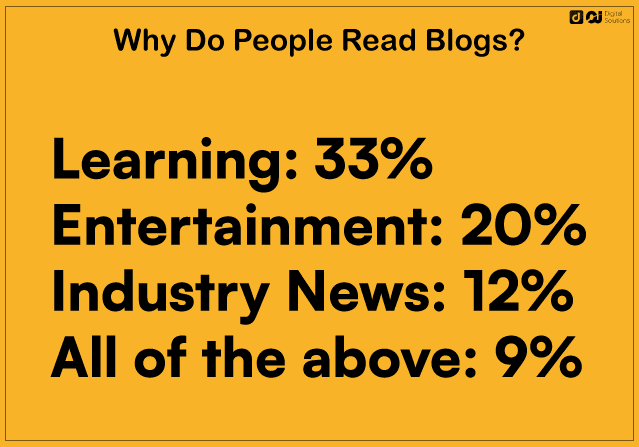
80% of Businesses Use Blogs for Digital Marketing. (Orbit Media)
If you’re wondering whether blogging is still relevant in 2022, the answer is yes.
A recent blogging statistic by Orbit found that most bloggers feel their blog delivers “results.”
This data hasn’t changed from 2016. Businesses still find blogs valuable for reaching their target audience.
77% of Fortune 500 Companies Have Blogs. (Statista)
Blogging is an essential digital marketing strategy for small and large businesses. In fact, 77% of the Fortune 500 have blogs (up from 50% a few years ago).
In 2019, 270 of the Fortune 500 used their company blogs for thought leadership, product promotion, and engagement.
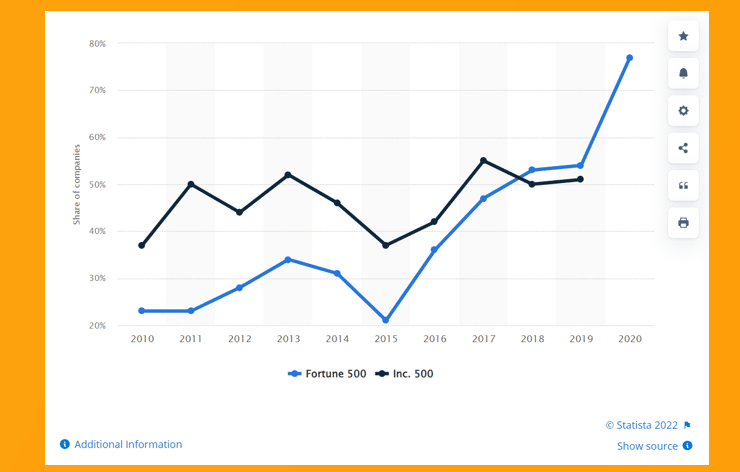
A Business Blog Can Help Companies Increase Their Web Traffic by 55%. (HubSpot)
A survey of 1,531 HubSpot customers found that companies that use blogs:
- See 55% more website traffic.
- Get 97% more inbound links.
- Have 434% more indexed pages.
Businesses That Blog Receive 126% More Leads Than Those That Do Not. (HubSpot)
If you haven’t started blogging for your business yet, it’s time to do so.
A study of 2,300 HubSpot customers found that businesses that blog experience 126% more monthly leads than those that don’t.
If you get ten leads per month, you could start getting 25 or more by adding a blog to your website.
People Leave Around 77 Million Comments per Month on Blog Posts. (WordPress)
Blog posts are an excellent way to get people talking on your site. Engaging customers and encouraging interaction can help improve your business.
According to WordPress, people leave roughly 77 million monthly comments on blog entries (and this is on WordPress sites alone).
B2B Bloggers Spend More Time on Each Article Than B2C Bloggers. (Orbit Media)
B2B bloggers seem more dedicated to content creation. They spend 26% more time on each article than their B2C counterparts.
As a result, B2B blogs offer readers a more informative and thought-provoking experience.
Blogging Platforms Statistics
Next, let’s look at some statistics revealing the platforms bloggers use.
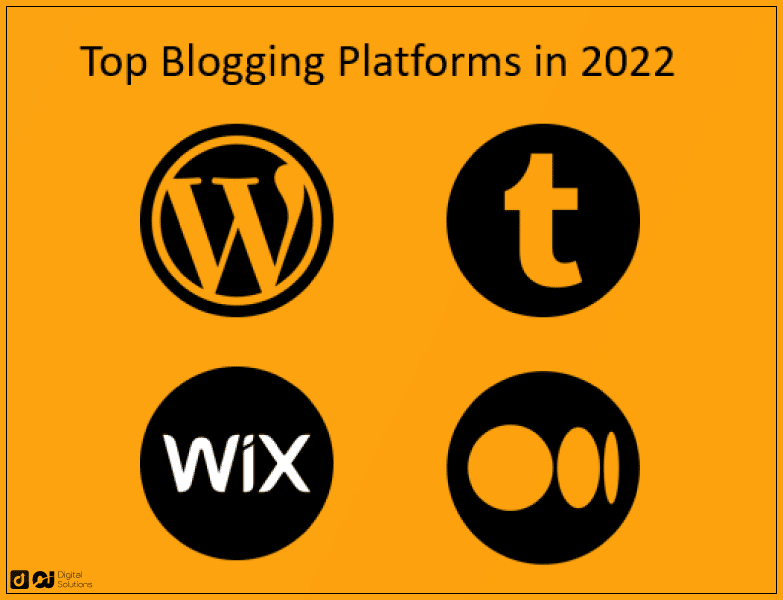
WordPress Is the CMS of Choice for 43% of All Websites on the Internet. (W3Techs)
According to W3Techs, nearly half of all business websites use WordPress to power their sites.
WordPress is popular because it has many features and plugins to help build the perfect website.
Tumblr Is Still the Most Popular Blogging Platform, With Almost 500 Million Blogs.
Although it’s not as well-known as WordPress or Wix, Tumblr is still the front-runner in blogging.
You can also find a community of like-minded bloggers on Tumblr, making it a great networking platform.
WordPress Powers About 60 Million Blogs.
WordPress lags behind Tumblr significantly in the number of blogs hosted on the platform. Still, it is home to around 60 million blogs.
Other CMS platforms contribute a total of 2.5 million blogs.
The Top Three Languages Used on WordPress Are English, Spanish, and Indonesian.
Speakers of many different languages use WordPress for blogging. Indonesian is the third most popular WordPress language, behind English and Spanish.
Wix Has Almost 200 Million Users Worldwide.
While Wix is still competing with WordPress for its place in the blogosphere, the platform is increasing in popularity.
With over 200 million active users, it’s clear that many people are finding value in what Wix has to offer. Its drag-and-drop web design features are popular among beginner bloggers.
Medium Has an Audience of Over 50 Million People.
Medium has recently gained popularity among businesses and thought leaders.
Since its launch in 2017, the platform has attracted more than 200,000 writers and 54 million users who have signed up.
Blog Readership Statistics
Now, let’s look at numbers about blog readers and blogging with images and videos.

Visuals Receive 94% More Views Than Other Types of Content. (B2B Marketing)
People are more likely to engage with content that contains relevant visuals. In fact, incorporating visuals into your blog content can increase views by 94%.
Adding images to your content can make a lasting impression and interest more people. Visual content also helps you get clicks and shares on social media.
Posts With More Than Seven Images Tend To Perform Better. (SEMrush)
Semrush’s Content Marketing 2022 Global Report says that articles with images get 116% more organic traffic than those without.
Photos are appealing and break up the text, making it easier to read. Readers are more likely to share articles with images, increasing organic search traffic.
Articles That Include Videos Receive 83% More Blog Traffic. (SEMrush)
Adding a video to your blog post is another way to grab the attention of readers just skimming.
The SEMrush report showed that articles with videos got 83% more blog traffic than those without.
These blog statistics come from a study that SEMrush did on 500,000 of the most successful blog posts.
Using Real People Photos Instead of Stock Photos Can Increase Conversion Rates By As Much as 35%. (Marketing Experiments)
Readers are more likely to convert when they see a non-stock photo. In a recent study by Venngage, the answer is also clear: original graphics perform the best.
41.1% of content marketers said original graphics were the most effective visuals in 2021. On the other side, 41.1% of marketers said stock photos were the worst-performing visuals.
The Use of Statistics in Blog Posts Increases Consumer Trust.
Statistics provide data that backs up your claims. Readers who see you using data are more likely to trust what you say.
Of course, this doesn’t suggest flooding blog posts with random statistics. It’s more effective to use only relevant statistics to boost reader trust.
A Colon or Hyphen in Your Title Can Make a Difference of 9%
A study found that a colon or hyphen in the title can increase the perceived quality of the writing by 9%.
While this may seem like a slight difference, it can be the difference between a reader giving your work a chance or passing it by.
36% of Blog Readers Favor Number-Based Headlines. (CXL)
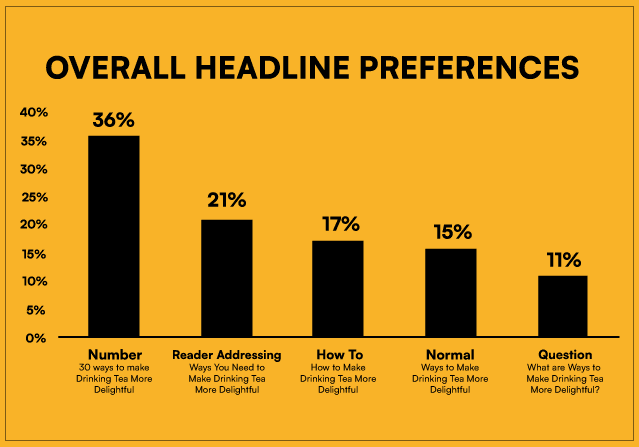
A study by CXL found that 36% of readers prefer blog posts that include numbers in the headline.
The study also found that the most popular form of numbered headlines is list posts, such as “3 ways to…” or “30 latest business blogging statistics…”
Odd-Numbered Headlines Outperform Even-Numbered Headlines.
Whether it’s a list of the top 10 things or a step-by-step guide, the number of items is likely to be odd. Why is this?
One study found that odd-numbered headlines have a 20% higher click-through rate. The reason for this is unclear, but it may have something to do with how our brains process information.
Odd numbers stand out more than even numbers, so they may grab our attention more.
People Tend To Read Blogs With Titles Between Six and 13 Words. (Optinmonster)
People are more likely to read blogs with titles that are between six and 13 words long. Our attention spans have gotten shorter, and information is constantly bombarding us.
A long title will bore us, while a short one won’t tell us enough about the blog. A title of the proper length will grab our attention and tell us whether we want to read more.
List-Based Headlines Are More Effective 36% of the Time. (Optinmonster)
List-based headlines are popular for many reasons. Blog readers can skim the headlines to get an idea of what the blog is about and then decide if they want to read more.
This type of headline also allows for easy sharing on social media.
Listicles Get Shared 2x As Much as Other Types of Posts. (SEMrush)
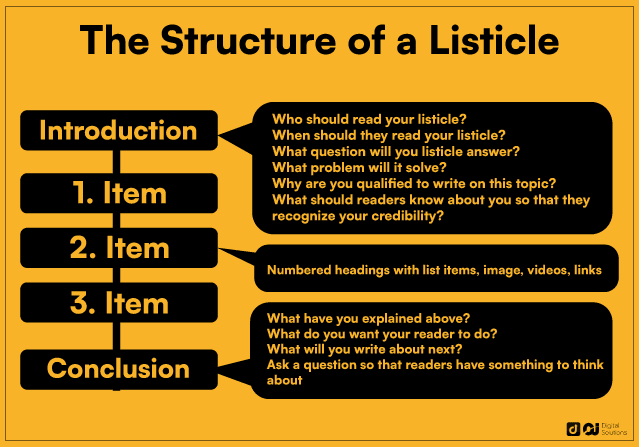
Listicles are a popular type of blog post because they are easy to read and packed with information.
Readers can quickly scan a listicle and find the information they want.
This format also makes it easy to share articles with others, so listicles are often shared twice as much as other blog posts.
59% of People Share Articles Without Reading Them First. (Chicago Tribune)
Nearly 60% of people share articles online without reading them first. That means it’s more important than ever to ensure the right people find your articles.
One of the best ways is to optimize your title, URL, and keywords for search intent.
43% of Readers Skim Articles. (HubSpot)
Four out of ten people who read blogs only skim them instead of reading every word.
It is one reason bloggers need to master the art of being straightforward—getting straight to the point without the fluff.
Most People Read Blogs on Chrome. (EarthWeb)
Recent business blogging statistics show that Chrome is the clear leader in the web browser market.
Chrome is famous for its speed and reliability, essential for a smooth browsing and reading experience.
More than 60% of internet users worldwide use Chrome, including 65% of desktop users and over 60% of mobile users. The next runner-up, Safari, only has about 19% of users.
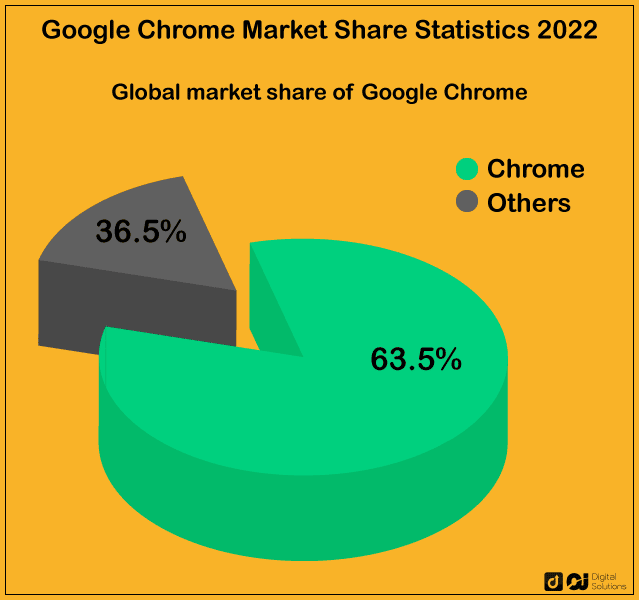
On Average, People Read Blog Posts Only for 52 Seconds. (Klipfolio)
A recent study showed that people only read blog posts for 52 seconds on average. That’s not very long! So, how can you ensure that your readers stick around until the end?
Here are a few tips:
- Keep your writing clear and concise.
- Get to the point and avoid unnecessary words.
- Use strong headlines that reflect the content of your post.
- Use images and lists to break up your text and make it easier to scan.
Blog Writing and Publishing Statistics
They say “content is king,” but how many blogs should you produce and publish monthly?
Let’s look at some facts about blog writing and publishing frequency and scale.
Blog Posts Usually Take 2 to 3 Hours To Write. (Databox)
A survey by Databox found that it takes respondents an average of 2-3 hours to write blog content, while it takes over 8 hours to produce video content.
It makes blogging much less time-consuming than other inbound marketing content creation.
Bloggers Who Spend 6+ Hours Writing a Blog Have 31% Better Results. (Orbit Media)
If you’re a blogger, you know that quality content is the key to success. But how much time should you spend writing each post?
Bloggers who spend at least six or more hours writing a post will likely see better results.
Bloggers Who Make the Most Money Are 6 Times More Likely To Do Their Own Research. (Function of Awesome)
Bloggers who make over $50,000 a year are six times more likely to conduct independent, original research.
The most successful bloggers will go the extra mile to create valuable information.
They’re also 5x as likely to have a podcast, 4.5x to post video content, and 3.7x to publish interviews.
Blogging 4 Times a Week Can Drive 3.5 Times More Traffic Than Blogging Once a Week. (HubSpot)

According to several business blogging statistics, business bloggers should post regularly.
Four or more posts per week are likely to generate three-and-a-half times more traffic than one post per week.
If four is too much, try two to four per week. Maintain a consistent posting schedule so readers know when to expect new content.
Bloggers Who Post Daily Are 128% More Likely To Report Strong Success in Their Outcomes. (Orbit Media)
Businesses that blog daily are 128% more likely to report substantial success in their results.
It shows that daily blogging may not be practical for everyone, but it can be profitable if you commit to it.
The Best Time To Post Blog Articles Is 7 A.M. (Shareaholic)
A study of 170,000 blog posts found that people read the most between 7:00 and 10:00 in the morning.
The Trackmaven study also found that Tuesday is the best day for posting blogs, followed by Thursday and Monday, which get the most shares.
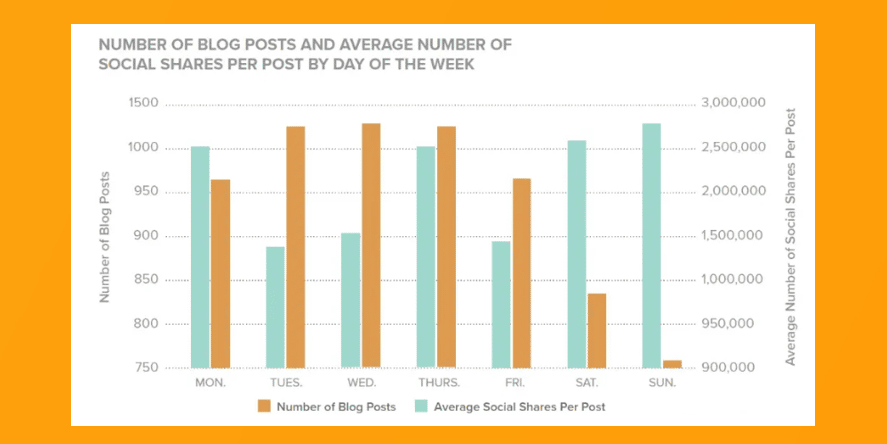
70% of Bloggers Regularly Update Their Old Posts. (Orbit Media)
Updating old blog posts creates new content. It saves time and provides correct, up-to-date information.
Review the information to see if anything has changed. Include new developments. Add new keywords or edit the title and meta description to boost SEO.
Longer Blog Posts Get the Most Social Shares. (SEMrush)
A few years ago, 600 to 800 words were a good length for a single blog post. But now, long-form content is becoming more popular.
In 2020, SEMrush found that blog posts with 7,000 words or more got the most shares and the best performance.
On Average, an Ideal Blog Post Length Is 1,500 to 2,000 Words. (BrightEdge)
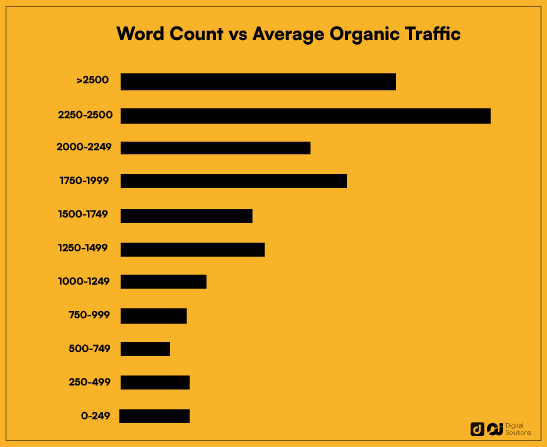
Long-form content is more informative and complete, making it more valuable. As a result, it is often the most shared and highest-ranking type of content on the web.
However, not everyone wants to read a super-long blog post. BrightEdge says the average blog post length should be 1,500 to 2,000 words.
More Than Half of Bloggers Write 2 to 3 Headlines Before Choosing One. (Orbit Media)
58% of bloggers will write two or three headlines for their blog posts before choosing the one they want.
On the other hand, only 1% of bloggers try 11 or more headlines.
Bloggers Who Conduct Original Research Are More Likely To Report Strong Results. (Orbit Media)
Some bloggers write about personal experiences or interests, while others specialize.
As a result, many blogs have become go-to sources for original research and analysis. 42% of bloggers surveyed by Orbit do their own research and see better results.
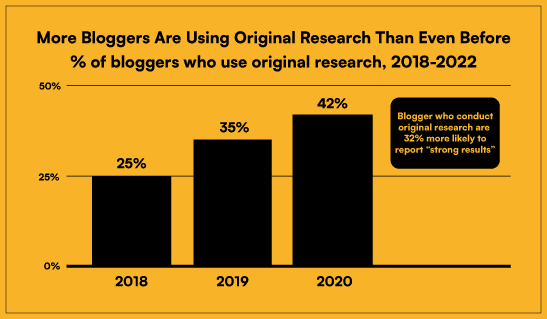
Articles With H1, H2, or H3 Headers Have Higher Performance. (SEMrush)
A study by SEMrush found that using header tags like H1, 2, and 3 can help improve the layout of a blog post.
It also makes it easier for readers to find the information they want. Header tags also boost SEO (search engine optimization).
SEO & Blogging Statistics for Marketers
In this section, let’s dive into some good blogging statistics that you can use for your blogging career or as a marketer.
Creating Content Costs 62% Less Than Traditional Marketing Formats. (Demand Metric)
Content creation saves money because you can easily make and share content. Also, you can repurpose content and use it more than once, which cuts costs even more.
70% of Bloggers Who Succeed Heavily Promote Their Content. (GrowthBadger)
Why do some bloggers find more success than others? A big reason is that they promote their blogs.
Seventy percent of bloggers who make over $50,000 a year actively promote their blogs.
That means they’re sharing their posts on social media, guest posting on other blogs, and even running paid ads.
In contrast, only 14% of bloggers who make less money try to self-promote.
96% of Bloggers Use Social Media To Promote Their Blog Posts. (Optinmonster)

Ninety-six percent of bloggers say they use social media to help increase their audience and reach.
However, it’s important to remember that not all social media platforms are equal.
For example, Twitter is great for posting links and snippets because of its quick pace.
Instagram, on the other hand, is more visual and thus better suited for sharing photos or videos.
Eight Out of Ten Bloggers Still Do Keyword Research for Their Blogs. (Databox)
Even though Google’s algorithm has improved at judging search intent, 83% of bloggers still do keyword research for their blog posts.
Google’s algorithm checks the blog post’s keywords to see if they’re relevant. If it is, then the blog post will appear in the search engine results pages.
72% of Online Marketers Say Content Creation Is the Best SEO Strategy. (Optinmonster)
If you’re a business owner, you must have a solid understanding of SEO. Search engine optimization is about improving your website’s ranking in search results.
Although there are many ways to do this, content creation is generally the best. After all, 72% of online marketers say that it’s the most effective SEO tactic.
Half of All Google Searches Come From Mobile Phones. (SISTRIX)
It’s no secret that people love using their phones and tablets to surf the web. Google receives over 100 billion monthly queries, with over half coming from mobile devices.
As a result, it’s crucial to ensure that your content is mobile-viewer-friendly. Avoid long paragraphs and use bullet lists and subheadings to split up and arrange your content.
75% of People Only Look at the First Page of Search Engines. (HubSpot)
As many as 75% of people never scroll past the first page. If your website is on the second page or beyond, people may never know your blog post exists.
Also, the top five spots on most search results pages receive 68% clicks.
Writing high-quality content will help your website rank well and drive traffic.
Blogs That Appear on the First Page of Google Include the Target Keyword in Their Title Tag. (Backlinko)
The title tag, shown on search engine results pages as the clickable headline, is one of the essential on-page SEO elements.
The Backlinko blogging stat shows that title tags still affect search engine rankings.
69% of Marketers Prefer Content Over Direct Mail and Public Relations. (Custom Content Council)
Content marketing strategy is becoming increasingly popular as businesses discover its benefits. This marketing strategy generates more leads and sales than email marketing and PR.
Blog content, articles, eBooks, infographics, and more are all options for content marketing strategy.
Bloggers That Work With Influencers See 70% More Success. (Orbit Media)
It makes sense—influencers have a built-in audience that trusts their recommendations. Bloggers can use influencers’ followers to expand their reach.
Influencers also know many people in their domain, which can help bloggers make new connections.
Bloggers That Use Analytics for Every Post Are 78% More Likely To Report Strong Results. (Orbit Media)
A survey found that bloggers who use analytics for every post are 78% more likely to report strong results. Analytics shows what is working well and what needs improving.
For example, if a blog post receives a lot of traffic, it could mean that readers enjoy that topic.
On the other hand, if a post is receiving little attention, you may need to revise it.
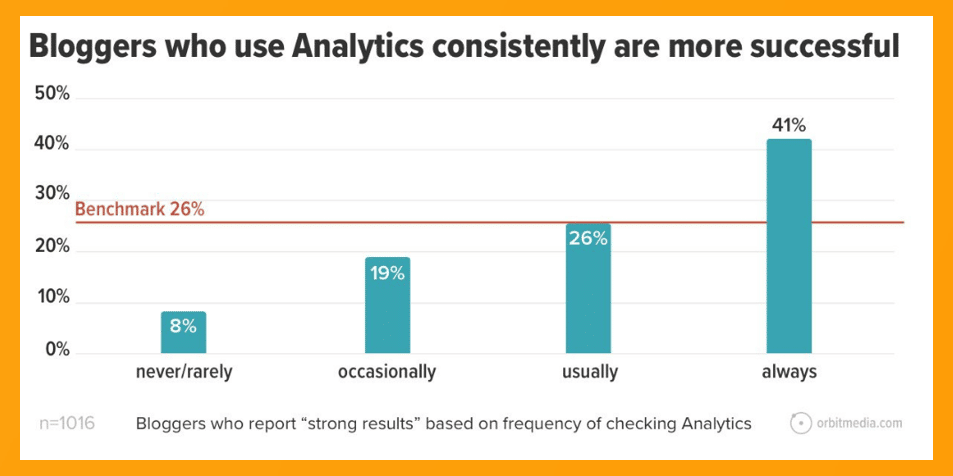
Guest Blogging Statistics
Guest blogging is a great way to connect on the web, build your brand, and earn passive income.
There’s no denying its effectiveness, either. Let me share some interesting blogging statistics on guest posting.
Six Out of Ten Bloggers Write One to Five Guest Posts a Month. (Referral Rock)
Guest posting has been an essential part of SEO strategy for years, but many bloggers are still unsure about how to make the most of this tactic.
Referral Rock found that more than 60% of bloggers guest post 1–5 times a month. Another study found that 93% of editors will continue publishing guest pieces.
79% of Editors Find Guest Content To Be Overly Promotional. (Optinmonster)
Most editors think that guest content is too much like advertising. It isn’t surprising since many guest authors write to promote their products or services.
But readers want content that’s useful and interesting. So, guest posts must balance self-promotion and helping the reader.
June, July, and August Saw More Guest Posts. (Optinmonster)
The summer months are typically a busy time for bloggers.
They are mostly too busy with holidays and outdoor activities to write original articles. Thus, demand for guest posting tends to increase during this period.
Blogging Statistics By Niche
Rank IQ says that food (42.8%), lifestyle (13.3%), and travel (10%) are the niches with the most blogs that get over 50,000 monthly visits.

Food Bloggers Have the Highest Median Monthly Income at $9,169. (Rank IQ)
Bloggers have a lot of options when it comes to monetizing their content. SEMrush reports that 42% of food bloggers generate money from ads and 10% from affiliate marketing.
A successful blog can also generate income through sponsored posts and product reviews.
Lifestyle and “Mommy” Blogs Are the Third Highest-Earning Niche in Blogging. (Rank IQ)
These blogs often focus on fashion, beauty, parenting, and home décor. They usually feature personal stories and advice.
Many lifestyle bloggers have built up huge followers. They earn cash through sponsorships, affiliate marketing, and advertising.
Some have also authored books related to their blog content.
59% of Travel Bloggers Run More Than One Blog About Their Travels. (Optinmonster)
59% of travel bloggers now operate more than one blog, with the majority of blogs being between 1 to 4 years old.
This suggests that many bloggers are starting more than one blog to take advantage of the growing demand for travel content.
Not surprisingly, travel bloggers make most of their money from sponsored posts.
The Bottom Line
Is blogging dead? The blogging statistics tell a different story—it is alive and well.
These business blogging statistics suggest you can reach your target audiences by publishing blog posts.
If you want to start your own blog, I hope this information will encourage you in your blogging efforts.
Remote workers also like blogging because they can work from home. See my 2023 Remote Work Statistics for more on the trend.




